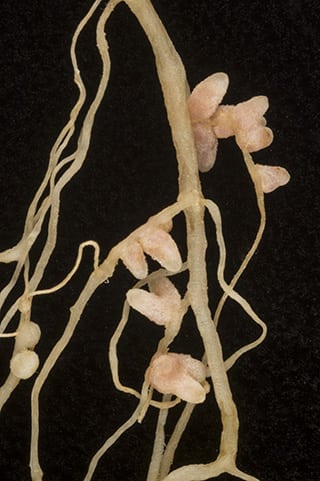A new way of engineering nitrogen fixation has been discovered by a UK-China research team, bringing us one step closer to realising the goal of engineering a range of crops to fix their own nitrogen.
One of the major factors that limit crop growth is the availability of nitrogen, but only bacteria and other single-celled microbes called archaea can take nitrogen from the air and fix it into a form that can be used by plants. The process carried out by these microbes is known as biological nitrogen fixation.
Legumes obtain nitrogen from symbiotic nitrogen-fixing bacteria, but cereal crops including wheat and maize, rely on the availability of fixed nitrogen in the soil. In many cases the addition of chemical fertilisers is the only way to provide crops with enough nitrogen to ensure a good harvest.
The use of nitrogen fertilisers releases nitrous oxide, a greenhouse gas which is 300 times more powerful than carbon dioxide. By engineering crops to fix their own nitrogen, we hope to reduce the use of nitrogen fertilisers, thus mitigating their impact on the environment. A break though like this could also have worldwide implications for cereal crop productivity.
In this paper, the research team has been able to engineer nitrogen fixation by employing a novel strategy, which simplifies the process of engineering multiple genes to make sure their expression is balanced in their new host. Nitrogen fixation is an intricate and delicate process which requires a balance of numerous key components. Until now, achieving the right balance of these components has been a major challenge to the engineering of nitrogen fixation in cereal crops.
The new method works by organising large numbers of genes which are required for nitrogen fixation into a smaller number of “giant genes”. These are then expressed in the host cell as huge proteins known as “polyproteins” which are subsequently cut by a specific protease enzyme to release the individual nitrogen fixation components. One innovative part of this method is how the group identified the amount of each component required, and then grouped these together. This step ensures that the right balance is produced.
Professor Ray Dixon project leader in molecular microbiology at the John Innes Centre said: “This is a really exciting development for synthetic biology because it brings nearer the aim of engineering nitrogen fixation in cereals.”
The collaborative Peking University – John Innes Centre team say that this exciting method will be useful for transforming complex systems from prokaryotes such as bacteria to eukaryotic hosts such as plants.
Professor Dixon continues, “In the future this method may also be applied to engineering metabolic pathways in plants to produce antifungal and antibacterial secondary metabolites that provide resistance to pathogens.”
Key findings from the study which appeared in the journal PNAS include:
- a post- translational protein-splicing strategy derived from RNA viruses was exploited to minimize gene numbers of the classic nitrogenase system to optimise the stochiometry of nitrogen fixation (nif) gene expression
- genes were grouped together on the basis of their expression levels and tolerance of their protein products toa C-terminal “tail” that remains after TEVp protease cleavage
- after multiple rounds of test-regroup cycles 14 essential genes were selectively assembled into 5 giant genes that enable growth on dinitrogen
Source: John Innes Centre












